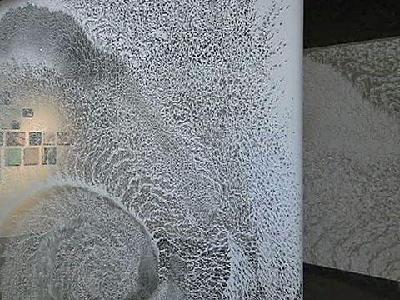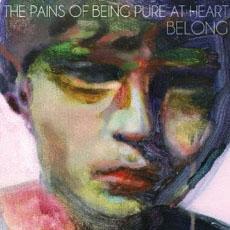
DOUG JOHNSON: Welcome to AMERICAN MOSAIC in VOA Special English.
(MUSIC)
I'm Doug Johnson. This week on our program: new music from two indie-rock bands ...
A question from Japan about the Cherry Blossom Festival here in Washington ...
And, in New York, a new exhibit of Japanese art.
(MUSIC)
Japanese Art Show
DOUG JOHNSON: A new art exhibit at the Japan Society in New York opened one week after the terrible earthquake and tsunami struck Japan. The exhibit was planned and the art created long before the disaster. But, the tragedy seems to affect visitors to the show. Faith Lapidus has more.
FAITH LAPIDUS: The Japan Society exhibit is called "Bye, Bye Kitty!!! Between Heaven and Hell in Contemporary Japanese Art." The organizers say the show questions Japan's love for cuteness, called kawaii in Japanese. The most famous image of kawaii is "Hello Kitty." The black and white cartoon cat with a bow is wildly popular among children and adults. She can be found on telephones, jewelry, clothing, and nearly everywhere on children's products.
The art in the Japan Society exhibit is decidedly not kawaii. Gallery director Joe Earle notes the darkness of the works.
JOE EARLE: "This exhibition represents a more mature view, if you like, one which can take account of catastrophes like earthquakes, problems at nuclear plants and tsunamis."
Mister Earle says neither the exhibit nor the artists expected the disasters. But Kent Bernard, a visitor to the show, says the disasters could affect how the art is received.
KENT BERNARD: "The things which you normally just do not see, except in artwork, we're now seeing in real life. It sort of reminds you that some of the fantastical things in art are outdone by nature."
Visitor Kent Bernard says one example is "Vortex" by artist Tomoko Shioyasu. The huge piece is made of paper. It was all carefully cut using knives and heated devices. The artist says she first began cutting paper after seeing the veins on a leaf. She thought they made a beautiful design.
"Vortex" represents nature and how it effects changes over time. But the work also recalls the unpredictable path and power of the recent tsunami.
Gallery Director Joe Earle says much of the exhibit suggests a sense of human powerlessness and future disaster. He notes the work "History of Rise and Fall" by Manabu Ikeda. It is an extremely detailed painting that includes many images of life, death and war. Joe Earle says the piece is appealing for its beauty, yet it also suggests society in collapse. And he says some of the images were born of real events.
JOE EARLE: "Up in the top left hand corner we have the contrails left by attacking jets or missiles from North Korea, an incident that actually happened during the long period Ikeda was producing this painting."
Mister Earle notes there are images of nuclear destruction. He says Ikeda's work was made before the crisis at the Fukushima Dai-Ichi power station. But, a visitor from San Francisco still makes the connection.
SHOW VISITOR: "That decay of humanity and decay of our environment, that may be one that I more resonated with in terms of feeling like you've captured life and that it does really decay under you."
"Bye, Bye Kitty!!! Between Heaven and Hell in Contemporary Japanese Art," includes the work of 16 artists. The show is to close June 16th.
(MUSIC)
Cherry Blossom Festival
DOUG JOHNSON: Our question this week comes from Japan. Joruji would like to know about the Cherry Blossom Festival in Washington, DC.
This year, the Cherry Blossom Festival ends Sunday. It began on March 26th. The two week event celebrates the 3,000 cherry trees that Japan gave to the United States in 1912.
Cherry trees line the tidal basin in Washington. The Thomas Jefferson memorial is also there. When the trees produce blooms, it is as if a large pink cloud has covered the whole area. Lovers, families and visitors enjoy slow walks around the water in the shelter of the beautiful blossoms.
This pleasure is the result of many years of appeals from a woman named Eliza Scidmore. She was a photographer, travel writer and the first female board member of the National Geographic Society.
Ms. Scidmore visited Japan in the year 1885. She was struck by the loveliness of the Sakura, or cherry trees. She decided these trees should grow along the Potomac River in Washington. She wrote of her hope for a "rosy tunnel of interlaced branches along the river's banks."
Eliza Scidmore proposed her idea to the federal official responsible for green space in Washington. He was not interested. Nor were any of the other men who held his job in the next 24 years.
But Ms. Scidmore did not give up. In 1909, she wrote to Helen Taft, the wife of then-President Howard Taft. Finally, Eliza Scidmore found a powerful ally.
In the return message, Mrs. Taft wrote:
"Thank you very much for your suggestion about the cherry trees. I have taken the matter up and am promised the trees."
On March 27th, 1912, Missus Taft and the wife of the Japanese Ambassador together planted two trees at a part of the river called the tidal basin. The ceremony was small but Eliza Scidmore attended. During the next several years, workmen planted the rest of the cherry trees.

In 1935, Washington held its first cherry blossom festival. Now, it includes the Cherry Blossom parade, which is held on the last Saturday of the festival. You can see huge helium balloons, bands and costumed marchers. The American Cherry Blossom Queen and the Japanese Cherry Blossom Queen ride together in the parade.
There are also parties, art exhibits, musical shows, kite flying and a foot race. And the last weekend of the festival includes the Sakura Matsuri Japanese Street Festival. It is the largest Japanese cultural event in the United States.
This year, the Cherry Blossom Festival is recognizing the tragic earthquake and tsunami in northern Japan. Festival organizers set up a collection with the Red Cross to gather money toward Japan's recovery from the disaster.
(MUSIC)
Two Indie Bands
DOUG JOHNSON: Today we play music by two "indie" rock bands -- The Mountain Goats and The Pains of Being Pure at Heart. Shirley Griffith has more.
(MUSIC)
SHIRLEY GRIFFITH: That was the song "Birth of Serpents" from The Mountain Goats new album "All Eternals Deck." The group's main musician is the singer and songwriter John Darnielle.
He began recording music in California more than 20 years ago. Sometimes he performs alone. Other times he works with other musicians to make albums under the name The Mountain Goats.
John Darnielle is known for writing richly poetic and often unusual songs about a wide mix of subjects. Critics are praising his latest effort for exploring new musical sounds. Here is the song "Beautiful Gas Mask."
(MUSIC)
Our next "indie" rock band has an unexpectedly long name: The Pains of Being Pure at Heart. The name comes from an unpublished children's book written by a friend of Kip Berman. He is the band's singer and guitar player. The Pains of Being Pure at Heart formed in 2007. The group released its first full-length album in 2009.
Here is the song "Belong" from their recent album of the same name.
(MUSIC)

Rolling Stone magazine praised the music in "Belong." It said the sound of the New York City band is now huge enough to match its big-hearted emotion. We leave you with "Heart in Your Heartbreak."
(MUSIC)
DOUG JOHNSON: I'm Doug Johnson. Our program was written by Caty Weaver and Dana Demange, who was also our producer.
If you ever miss a program, or want to search for subjects that interest you, go to voaspecialenglish.com. You can download transcripts and MP3s of all of our shows.
You can also send us questions about American life. Write to mosaic@voanews.com. And we're on Facebook and Twitter at VOA Learning English.
Join us again next week for music and more on AMERICAN MOSAIC in VOA Special English.
'Maximum INDIA' brings India's sights and sounds to Washington
Art by Japanese-American detainees during World War Two shows their struggle and humanity
Washington hosts annual Japanese Cherry Blossom Festival
(来源:VOA 编辑:崔旭燕)
